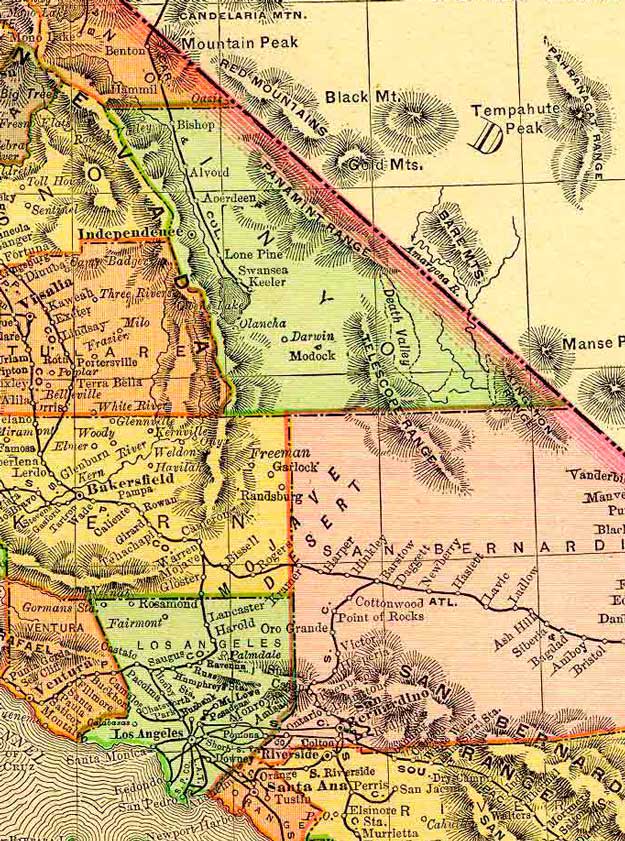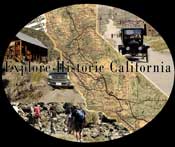In February 1872, the Los Angeles News
reported “To this city, the Owens River is invaluable. What Los
|
 |
|
Remi
Nadeau |
Angeles now is, is mainly due to it. It is the silver cord that
binds our present existence.” The freighter responsible for this
was Remi Nadeau, whose blue painted wagons and long strings of
mules traversed the Yellow Grade Road from the Cerro Gordo Mines
across the desert to Los Angeles and on to the port of San
Pedro. Nadeau’s wagons transported silver-lead bullion for later
refining in San Francisco and returned to Owens Valley with all
manner of supplies, including bales of hay, casks of wine,
potatoes, frying pans, and crates of live chickens.
In reality, while Nadeau probably had the largest
contract and largest route, there were many other brave and
rugged men who packed mules and wagons in the Owens Valley, the
Sierras and Inyo Mountains.
 |
|
Portion of 1895 Railroad map of California. As rail
service improved, many freighters went on to other
enterprises or relocated to areas well removed from
railroads.
Ironically, some rail lines, such as Southern
Pacific's Jawbone Line that connected Lone Pine (Owenyo)
with Mojave, later fell victim to modern day
freighters in the form of big rig highway trucks.
Nadeau
left the freighting business in 1883. He built the
Hotel Nadeau on the site in downtown Los Angeles
that was his mule stable and headquarters. He
also became involved in diversified agricultural
enterprises.
Today
Owens Valley is dotted with location names that tie
in with many of the nineteenth century freighters. |
Carmen and Henry Olivas
Carmen Olivas was born in 1869 and died in 1939.
During his lifetime of packing that lasted until his retirement
in 1930, he took supplies of groceries, lumber, rails, machinery
explosives, and drinking water to the mines and camps of
Beveridge, Keynot, McElvoy Canon, Cerro Gordo, Burgess, Hunter
Canyon, Bunker Hill, and Louis Camp on the Kern, as well as many
others. On his way out he brought highgrade ore and pinon
firewood.
The sheep herders and cattle grazers of the
Sierra Nevadas were supplied with salt and wine by the Olivas
outfit. In 1916, Carmen and his son, Henry, who was 10 or 11
years old, were sent up to the last of the sheep camps at Rock
Creek Lake. The herders had left the sheep in the mountains too
long and the snows came. Carmen and Henry went in with their
pack train of mules burdened with two bales of hay a piece. They
trekked through three feet of snow to get to the sheep. The
morning after they reached them the mules were driven out of
Diaz Pass first so they would pack the snow down enough the
sheep could follow.
The owner of the Burgess Mine that straddles New
York Butte in the Inyo Mountains, was a woman named Kate Wells.
As Carmen and Henry packed high grade ore down the rugged road
to the Lone Pine Railroad Station, Kate would come along with a
shotgun to make sure they weren’t hijacked by bandits. Two years
after their ore contract, Kate herself was packed over the crest
to the salt tram station and loaded on the tram to Swansea. Kate
and a miner named Smalley had been loading timber at the mine,
when a mule whirled around and the timber on his back caught her
on the side of the head, breaking her neck.
From 1912 to 1923, Carmen ran trains of 8 to 10
mules carrying pinion pines “5 mules to a cord” from the
mountains above Swansea. The wood was cut by one of his
employees, then cut in to 4 foot lengths which Henry would spend
school weekends sawing into stove lengths. They made sixteen
dollars a cord for their hard work.
During their long packing career, the Olivas
family also hauled bags of compressed snow from Lone Pine Canyon
for summer refrigeration in Owens Valley towns. National Park
rangers from Sequoia and General Grant hired Carmen to transport
their equipment, and materials were also hauled for the east
side of the Mount Whitney trail from the Owens Valley. From 1905
to 1907, materials and dirt for building and grading of the
Yosemite Valley Railroad bed was carried by Olivas mule trains.
Supplies and tourists were packed to resort type
camps. Henry took deer hunters and fisherman with furnished
saddle horses, teams and pack mules for the movies. Many parties
were as big as six packers, 40 mules and 30 horses. He wrangled
for the various companies off camera, providing horses, mules,
cows, extras, and stagecoaches for shoots in the Southern
Sierras. In 1949 he drove a 4-horse team from Lone Pine to Death
Valley for the tv show Death Valley Days. When the script called
for a 20 mule team Henry drove it for the show, also.
William G. Dixon
William G. Dixon came west to become principal of
the Inyo Academy, a Methodist Mission School in 1889. In later
years he returned to his real profession of Civil Engineering.
He surveyed and helped build the Owens River Canal to the
Sunland area. He moved to Big Pine and he and his son John would
outfit a light rig with a team of mules which they would take to
the old trails as far back as they could until they had to
unhitch the teams and use them as pack mules to explore the
mines. Sometimes they barely found enough water for themselves
and the mules, and were lucky to return alive.
The Dixon family helped to organize the Fourth of
July activities in Big Pine. The church people put on a dinner
charging 50 cents for all you could eat, from food donated by
local ranchers and their wives. William and his sons would load
up the pack mules in the wee hours of the morning and head up to
the Mount Alice glacier. Here they loaded up with ice and came
back into town around 10 a.m. The women of the community waited
with a large hand-cranked freezer to make ice cream to follow
the dinner.
Reuben Cook Spear
Originally from England, Reuben Cook Spear came
to Lone Pine in 1874 at the age of 22. He partnered with
blacksmith and wagon shop owner, A.C. Harvey, and eventually
acquired the business from him. His heart was in the mines,
however, and he eventually had interests in Beveridge, Burgess,
Cerro Gordo, Darwin, Panamint Valley, Ubehebe, and in Nevada.
“Reub” hauled workers back and forth by pack
train during the survey of the salt tram until the tram was well
under construction. He also packed and distributed wire from
Monache to Beach Meadows from the Tunnel to Kern River during
the forest service Sierra telephone installations.
Groups of tourists were occasionally led into the
Sierras by Reub. Animals were rented for one dollar a day and
the packer worked for three dollars. During the Burgess mining
boom, he packed heavy freight to New York Butte for a cent a
pound. His mules carried ore down the road from the Santa Rosa
mine to the leasers known as “Cloriders”.
William L. Hunter
Hunter Mountain is named after William L. Hunter
who operated a large pack train of mules in Cerro Gordo. The
Hunter house that still stands in the ghost town today belonged
to his family. The pack business was profitable but he
eventually gave it away to pursue mining
interests in the southern Inyos.
A mile away and a canyon over from the Big Horn
mine, near a spring in a little hanging valley Hunter built a
cabin with a thatched roof and three steam engine powered
arrastras. The engine and boiler were brought up the Swansea
road, then up the steep Flagstaff grade.
A quarter of the way up, there was no road
whatsoever, and Hunter would have had to pick his own way. He
succeeded in pulling his wagon and machines all the way to the
summit. The wagon made it to Burgess on the southern shoulder of
New York Butte, the first wagon and perhaps the last, on the
summit. At Burgess the Hunter trail from Lone Pine crossed the
summit into Craig’s Canyon. From here it turns north into the
head of Hunters Canyon then winds down several miles to the
spring.
Engines were dismantled at the summit, and then
packed down on mules (except the engine base, the tubular boiler
and a large cogwheel). These were loaded on separate mules
secured by a diamond hitch. The rough terrain and heavy load was
a struggle for the mules, with exhaustion setting in every
hundred feet.
The men would transfer the load from mule to mule
many times until they reached the 11,000 foot summit of New York
Butte. Hunter’s grandson said, “The cogwheel at least in size,
gave them endless trouble and grief. I was never told how many
mules collapsed or failed in this operation.” On the north
shoulder of New York Butte they built skids, pulling the
machinery several miles down steep canyon sides to the spring.
This was in 1880.
William Arcularius
“Wm. Arcularius, the teamster, the other day had
a lively time with his pet mules at Cerro Gordo Landing. The
gentle mules started to run him a race and after smashing the
wagons won the race and of course the stakes, consisting of a
shower of blacksnaking,” reported the Inyo Independent in 1877
Eighteen mules and two horses made up Arcularius’
team for heavy freighting. The horses worked as wheel horses,
guiding the rest of the team. The two mules in front of the
horses were known as the pointers and were responsible for
keeping the wagon in the tracks. In front of the pointers were
the swing mules that would jump the chain in order to keep the
wagon in tracks at crooked canyon roads, and when they needed to
initiate a turn. Commands such as Gee or Haw, directed the well
trained mules towards the proper direction.
It was rare when a mule did not listen to
Arcularius, but when they didn’t there was always the long
blacksnake. Arcularius believed that a mule was like a young boy
and needed a lashing every few weeks. Rose and Mary, the lead
mules were so well trained he never needed to whip them. It
appeared they understood absolutely everything he said to them.
A jerk line drove the mule team. Arcularius, who
felt a mule worked best when handled by one person at all times,
was always the driver. A wagon, trailer, water tank and feed
tank were pulled. He worked out of Bodie and Calico, and hauled
lead and supplies back from Keeler and Darwin. Ore was also
hauled from the numerous mines to the smelters in Tonopah,
Nevada.
William Arcularius was known to take excellent
care of his stock, but always made sure they knew he was boss,
never hesitating to correct their misbehaviors on the spot with
the blacksnake. A few miles outside of Darwin a man once
confronted him on the abuse of his mule. Arcularius ignored the
man, who constantly tantalized him until he couldn’t take it any
more. Arcularius took out after the man, known as Alkali Bill,
and chased him into a Darwin saloon.
